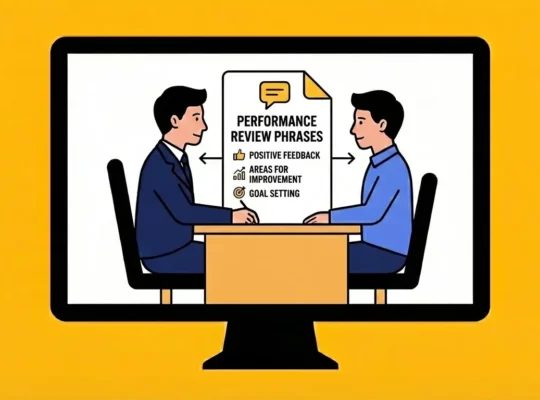New employees often arrive on their first day brimming with excitement and a touch of uncertainty. They’re eager to prove themselves, but unsure of what’s expected and how to contribute effectively. Setting clear goals is crucial to bridge this gap, providing a roadmap for success, and fostering a more positive onboarding experience. At Review.jobs, we understand how effective goal-setting practices can significantly impact employee experience, performance, and retention. This article explores the “why” behind goal setting, delves into different types of goals, and provides practical strategies for implementation and support.
- Why Goal Setting is Crucial for New Employees
- Types of Goals for New Employees
- The SMART Goal Framework
- Implementing a Goal-Setting Program
- Best Practices for Supporting New Employee Goals
- Overcoming Challenges in Goal Setting
- FAQs
I. Why Goal Setting is Crucial for New Employees
1. Clarity and Direction
The initial stages of a new role can be akin to stepping into a whirlwind. New hires are often inundated with information, expectations, and a steep learning curve. This can lead to feelings of overwhelm and uncertainty, hindering their ability to contribute effectively.
Setting a smooth onboarding process and defining clear goals act as a guiding compass, providing direction and focus. By understanding their specific objectives, new employees can navigate their roles with confidence, prioritize tasks efficiently, and align their efforts with the broader organizational goals. This clarity not only reduces anxiety but also accelerates the onboarding process, enabling new hires to become productive contributors more quickly.
2. Motivation and Engagement
Goals are the compass that guides employees toward success. When individuals have clear, achievable objectives, they experience a heightened sense of purpose and direction. This intrinsic motivation translates into increased engagement and dedication. Unlike merely completing tasks, engaged employees actively contribute to the organization’s success, viewing their work as meaningful and impactful.
This heightened engagement manifests in increased productivity, improved quality of work, and a more positive work environment. Employees who are invested in their goals are more likely to take ownership of their work, seek out challenges, and collaborate effectively with their peers. Ultimately, goal setting empowers employees to reach their full potential and drive organizational success.
3. Alignment with Organizational Objectives
Effective goal setting is not merely about individual performance; it’s about ensuring that every employee’s efforts contribute meaningfully to the company’s overarching objectives. By aligning individual goals with broader organizational strategies, companies create a sense of purpose and unity.
When employees understand how their work impacts the bigger picture, they become more engaged and invested in their roles. This alignment fosters a shared vision and drives collective success, as everyone is working towards a common goal. It’s essential to communicate organizational objectives clearly and transparently, ensuring that new employees understand how their work contributes to the company’s mission and vision.
4. Building Confidence and Autonomy
When individuals understand their role in the bigger picture and have specific objectives to work towards, they are more likely to take ownership of their work. This sense of ownership fosters a proactive mindset, encouraging employees to seek out challenges, make decisions, and contribute innovative solutions.
As employees achieve milestones and gain confidence, they naturally gravitate towards greater autonomy. This increased independence not only boosts morale but also enhances job satisfaction. Empowered employees are more likely to feel valued and invested in the company’s success, leading to higher levels of engagement and productivity.
5. Reducing Turnover
New hire turnover presents a significant challenge for organizations. With approximately 20% of employees leaving within their first 45 days of employment, the costs associated with recruitment, onboarding, and lost productivity are substantial. This statistic underscores the critical importance of a robust onboarding process that fosters a sense of belonging and purpose from the outset.
By implementing a well-structured goal-setting program, organizations can mitigate the risk of early turnover. When new employees have clear objectives, feel supported in their roles, and see a clear path for growth, they are more likely to remain engaged and committed to the company.
II. Types of Goals for New Employees
To effectively guide new employees toward success, it’s essential to set a variety of goals that address both performance and development. Here’s a breakdown of key goal types:
Performance Goals
Performance goals focus on achieving specific, measurable outcomes related to an employee’s job responsibilities. These goals directly contribute to the organization’s objectives and provide clear benchmarks for success.
- Key Performance Indicators (KPIs): These metrics align with the employee’s role and the company’s overall goals. Examples include sales targets, customer satisfaction scores, or project completion rates.
- Efficiency Goals: Aiming to improve productivity and reduce task completion time can be a valuable performance goal. For instance, increasing processing speed by 15% or reducing error rates by 20%.
- Quality Goals: Focusing on delivering high-quality work is crucial. This could involve meeting specific quality standards, reducing defects, or increasing customer satisfaction.
Development Goals
Development goals focus on enhancing an employee’s skills, knowledge, and abilities. They are essential for career growth and long-term success for both new hires and managers.
- Skill Acquisition Goals: Targeting specific skills or competencies to be developed within a defined timeframe. For example, learning a new software program or mastering a particular technique.
- Knowledge Expansion Goals: Focusing on broadening an employee’s understanding of the industry, company, or role. This can involve attending industry conferences, completing certifications, or engaging in research.
- Career Advancement Goals: Setting goals related to career progression, such as taking on new responsibilities or preparing for leadership roles.
Project-Based Goals
For roles that involve specific projects or initiatives, project-based goals can be particularly effective. These goals align individual contributions with the overall project objectives.
- Project Milestones: Defining specific milestones within a project timeline to track progress and ensure timely completion.
- Collaboration Goals: Encouraging teamwork and cooperation by setting goals related to cross-functional collaboration or knowledge sharing.
- Innovation Goals: Promoting creativity and problem-solving by setting goals focused on developing new ideas or solutions.
Adaptive Goals
In today’s rapidly changing business environment, it’s essential to incorporate flexibility into goal setting. Adaptive goals allow for adjustments based on changing circumstances and emerging opportunities.
- Stretch Goals: Setting challenging but achievable goals that push employees to reach their full potential.
- Learning and Development Goals: Encouraging continuous learning and adaptation to new challenges.
- Flexibility and Agility: Building in flexibility to allow for adjustments as needed.
III. The SMART Goal Framework
Introduction to SMART Goals
The SMART framework provides a structured approach to crafting effective goals. By ensuring goals are Specific, Measurable, Achievable, Relevant, and Time-bound, you increase the likelihood of success and provide a clear roadmap for progress.
- Specific: Clearly define the desired outcome, leaving no room for ambiguity. Who, what, when, where, and why are all essential components of a specific goal.
- Measurable: Establish clear metrics to track progress and assess performance. How will you determine if the goal has been achieved?
- Achievable: Goals should be challenging but attainable. Consider the employee’s skill level and experience when setting goals.
- Relevant: Ensure that goals align with the employee’s role and contribute to broader organizational objectives.
- Time-bound: Set a clear deadline for achieving the goal. This creates a sense of urgency and helps with focus.
Creating SMART Goals
- Marketing Role: Increase the company’s social media following by 20% within the next six months by creating engaging content and running targeted ad campaigns.
- Sales Role: Close 15 new accounts in the first quarter, generating $100,000 in revenue.
- Customer Service Role: Improve customer satisfaction scores by 10% over the next quarter through enhanced training and support initiatives.
Remember: It’s essential to collaborate with new hires when setting goals. By involving them in the process, they’ll feel more invested and committed to achieving their objectives.
IV. Implementing a Goal-Setting Program
A well-structured goal-setting program is the cornerstone of integrating new employees into your organization and setting them up for success. This program fosters a collaborative environment, clarifies expectations, and provides a roadmap for ongoing development. Here’s a breakdown of the key steps involved:
Collaborative Goal Setting
Importance of Involving New Hires
Engaging new hires in the goal-setting process goes beyond simply assigning them tasks. It fosters a sense of ownership and commitment that translates into higher motivation and engagement. Here’s why involving new hires is crucial:
- Increased Understanding of the Role: When new hires actively participate in setting goals, they gain a deeper understanding of their role and its contribution to the team and organization.
- Improved Buy-In: By collaborating on goal creation, new hires feel invested in achieving them, fostering a stronger sense of ownership and accountability.
- Identification of Development Needs: The goal-setting process can uncover existing skill gaps or areas for improvement, allowing for targeted development plans.
- Enhanced Communication: Open communication during goal setting strengthens the relationship between new hires and their managers.
Tips for Effective Two-Way Conversations
Effective communication is vital for ensuring collaborative goal setting. Here are some tips for fostering productive two-way conversations:
- Active Listening: Give new hires your full attention and ask open-ended questions to understand their aspirations, strengths, and potential challenges.
- Open Communication: Create a safe space for open dialogue and encourage feedback throughout the process. This helps tailor goals that are realistic and achievable.
- Shared Ownership: Work together to ensure both the employee and manager agree on the goals and the steps needed to achieve them. This fosters a sense of mutual responsibility.
- Flexibility: Be open to adjusting goals as needed. New hires may gain new skills or encounter unforeseen circumstances. Remain flexible to adapt the goals for continued success.
Documentation and Tracking
Once goals are established through collaborative discussions, documenting and tracking progress becomes crucial:
- Utilize Goal-Setting Software: Consider utilizing specialized software that streamlines the goal-setting process. These tools often offer features for setting clear objectives, assigning deadlines, and tracking progress with automated reports.
- Regular Check-Ins: Schedule regular check-ins throughout the goal achievement timeframe. These meetings provide an opportunity to discuss progress, offer feedback, address challenges, and celebrate successes.
- Visualize Goals: Utilizing dashboards, progress trackers, or Kanban boards can visually represent goal achievement. This helps employees stay motivated and focused on their objectives.
V. Best Practices for Supporting New Employee Goals
Providing Clear Expectations and Guidance
Setting new employees up for success begins with clear communication and support. By providing clear expectations and guidance, you can help them navigate their roles and achieve their goals effectively.
- Setting Clear, Attainable Goals: Ensure that goals are specific, measurable, achievable, relevant, and time-bound (SMART).
- Communicating Expectations Effectively: Clearly articulate the desired outcomes and performance standards. Use examples and visuals to enhance understanding.
- Providing Necessary Resources: Equip employees with the tools, resources, and support they need to achieve their goals.
- Offering Ongoing Guidance: Provide regular feedback and coaching to help employees stay on track and overcome challenges.
Creating a Supportive Environment
Fostering a supportive work environment is crucial for goal achievement. By creating a positive and encouraging atmosphere, you empower employees to take ownership of their goals and strive for excellence.
- Mentorship and Coaching: Assign mentors to guide and support new employees in their goal-setting journey.
- Collecting Employee Reviews: Encourage open communication by collecting anonymous reviews through a trusted employee review management platform.
- Celebrating Successes: Recognize and reward achievements to boost morale and motivation.
- Addressing Challenges Proactively: Provide support and resources to help employees overcome obstacles.
Leveraging Technology for Goal Management
Technology can significantly enhance the goal-setting and tracking process. By utilizing the right tools, you can streamline workflows, improve collaboration, and provide valuable insights.
- Goal-Setting Software: Employ specialized software to create, track, and manage goals efficiently.
- Performance Management Platforms: Ask insightful performance review questions and integrate goal setting for a holistic approach.
- Real-Time Feedback Tools: Utilize platforms that enable continuous feedback and recognition.
- Data Analytics: Leverage data to measure goal progress, identify trends, and make informed decisions.
Recognizing and Rewarding Achievements
Celebrating successes is essential for motivating employees and reinforcing desired behaviors. By recognizing and rewarding goal achievement, you demonstrate your appreciation for their hard work and commitment.
Effective Recognition Strategies
- Public Recognition: Celebrate employee achievements in company-wide forums, such as town halls or newsletters.
- Peer-to-Peer Recognition: Encourage employees to recognize and appreciate their colleagues’ contributions.
- Managerial Recognition: Regular one-on-one recognition from managers is crucial for building strong relationships.
- Personalized Rewards: Offer rewards that align with individual preferences and interests.
- Tangible and Intangible Rewards: Combine monetary rewards with non-monetary incentives like additional time off or professional development opportunities.
VI. Overcoming Challenges in Goal Setting
Overcoming Resistance to Change
Challenge:
Implementing a new goal-setting process can often meet resistance from employees who are comfortable with the status quo.
Strategy:
- Communicate the Benefits: Clearly articulate how the new goal-setting process will improve their work experience, such as increased clarity, better work-life balance, and enhanced career growth opportunities.
- Pilot Program: Implement the new process with a smaller group of employees to gather feedback and refine the approach before a full rollout.
- Training and Support: Provide comprehensive training on the new system and offer ongoing support to help employees adapt.
- Incentivize Adoption: Offer incentives or rewards for early adopters of the new goal-setting process and implement employee engagement programs to keep your team hooked.
Measuring Goal Achievement and Impact
Challenge:
Quantifying the impact of goal setting can be difficult, making it challenging to demonstrate its value to stakeholders.
Strategy:
- Define Key Performance Indicators (KPIs): Establish clear metrics to measure goal achievement and overall performance.
- Track Progress Regularly: Monitor goal progress and identify areas for improvement.
- Conduct Post-Implementation Evaluations: Assess the effectiveness of the goal-setting process and identify areas for enhancement.
- Correlate Goal Achievement with Business Outcomes: Demonstrate how goal achievement contributes to overall organizational success.
Balancing Short-Term and Long-Term Goals
Challenge:
Aligning immediate objectives with broader organizational strategies can be complex.
Strategy:
- Cascade Goals: Break down long-term organizational goals into smaller, achievable steps for individuals and teams.
- Regular Alignment Checks: Ensure that individual goals remain aligned with evolving business objectives.
- Balance Metrics and Outcomes: Track both short-term performance metrics and long-term impact indicators.
Overloading Employees with Goals
Challenge:
Setting too many goals can lead to overwhelm and decreased focus.
Strategy:
- Prioritization: Help employees identify and focus on the most critical goals.
- Goal Refinement: Encourage employees to regularly reassess and prioritize their goals based on changing circumstances.
- Limit Goal Number: Encourage employees to focus on a limited number of core goals to maximize impact.
Measuring and Evaluating Goal Progress
Challenge:
Tracking and measuring progress toward goals can be time-consuming and complex.
Strategy:
- Leverage Technology: Utilize goal-tracking software to automate data collection and analysis.
- Regular Check-ins: Conduct regular check-ins to assess progress and provide feedback.
- Visualize Progress: Use dashboards and reports to provide a clear overview of goal achievement.
Ensuring Goal Alignment Across Teams
Challenge:
Aligning goals across different departments and teams can be challenging.
Strategy:
- Cross-Functional Collaboration: Encourage cross-functional teams to collaborate on goal setting to ensure alignment.
- Shared Objectives: Define overarching organizational goals and cascade them down to individual teams.
- Regular Communication: Maintain open communication channels across teams to facilitate coordination and support.
Effective goal setting is a cornerstone of high-performance organizations. By combining clear goal definition, supportive leadership, employee empowerment, and the right technology, organizations can create a culture of achievement and growth. Review.jobs is committed to supporting businesses in their goal-setting initiatives. Our platform provides the tools and resources needed to enhance employee engagement, drive performance, and foster a culture of continuous improvement.
FAQs
- How many goals should a new employee have?
The number of goals will vary depending on the employee’s role and the complexity of their work. Generally, three to five key goals are manageable. However, it’s essential to prioritize these goals and ensure they align with broader organizational objectives.
- Should goals be purely performance-based, or should they include development goals as well?
Both performance and development goals are crucial. Performance goals focus on immediate outcomes, while development goals prepare employees for future roles. A balanced approach is recommended.
- How can I ensure that goals are challenging yet achievable?
Collaborative goal setting is key. Involve employees in the process and encourage them to set challenging but realistic goals. Regularly review and adjust goals as needed to maintain motivation and engagement.
- How can I address resistance to goal setting among employees?
Communicate the benefits of goal setting, such as increased clarity, improved performance, and career growth. Offer training and support to help employees understand the process.
- How can I make goal-setting a continuous process?
Encourage regular check-ins, provide ongoing feedback, and offer opportunities for employees to adjust their goals as needed. Treat goal setting as a dynamic process, not a static event.
- How can I measure the effectiveness of my goal-setting program?
Track key metrics such as employee engagement, performance, and retention. Conduct surveys to gather employee feedback on the goal-setting process. Analyze goal achievement data to identify areas for improvement.





